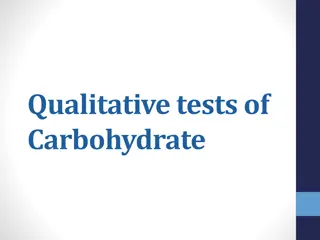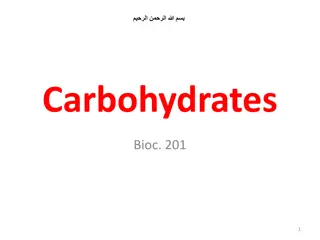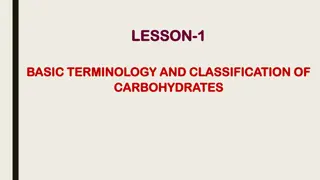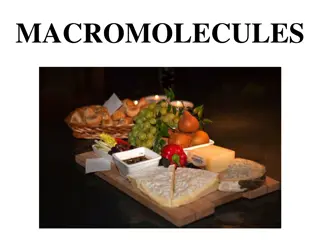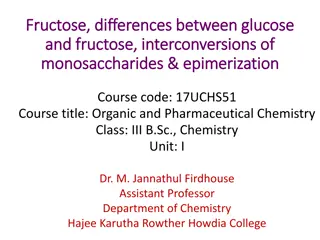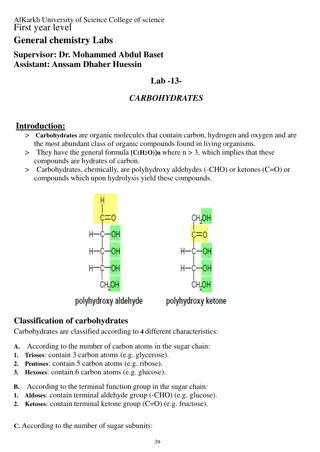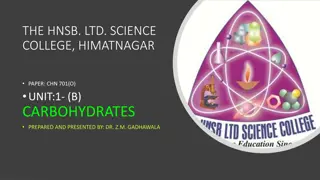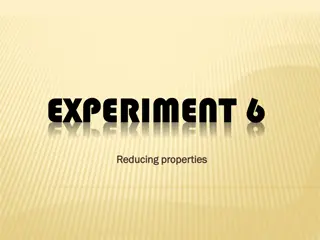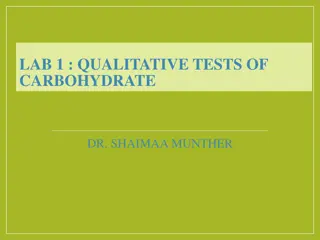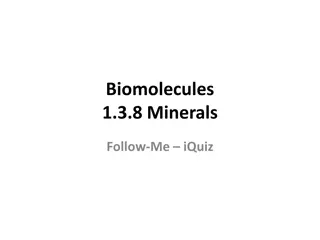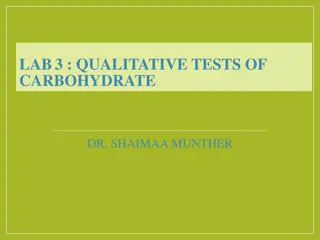Reagent Preparation for Food Analysis: Barfoed's and Seliwanoff's Tests
Preparation of reagents such as Barfoed's reagent and Seliwanoff's reagent is essential for detecting monosaccharides in food analysis. Barfoed's test utilizes a mixture of acetic acid and copper(II) acetate to detect reducing sugars, while Seliwanoff's reagent helps identify ketoses in solutions. U
2 views • 19 slides
Understanding Digestion and Absorption in the Gastrointestinal Tract
Digestion and absorption in the gastrointestinal tract are crucial processes for breaking down carbohydrates, fats, and proteins into smaller compounds that can be absorbed by the body. Carbohydrates undergo hydrolysis to convert into monosaccharides, fats are broken down from triglycerides, and pro
1 views • 22 slides
Understanding Qualitative Tests of Carbohydrates
Carbohydrates are vital sources of energy in living organisms and play a significant role in cell structures. This article covers the classification of carbohydrates, including monosaccharides and polysaccharides, and explores their solubility properties. It also delves into the distinction between
0 views • 22 slides
Understanding Carbohydrates: The Essential Biomolecules in Nature
Biomolecules are vital molecules found in all living organisms, primarily composed of carbon along with other elements like hydrogen, oxygen, and nitrogen. Carbohydrates, the most abundant organic molecules in nature, are important sources of energy and serve as structural precursors for various com
0 views • 15 slides
Understanding Carbohydrates: Essential Organic Molecules in Nature
Carbohydrates, also known as saccharides, are crucial organic compounds that serve various functions in living organisms. They are a major energy source, play a role in energy storage, contribute to cell structure, and are essential components of DNA and RNA. Carbohydrates are classified into four g
0 views • 80 slides
Understanding Basic Terminology and Classification of Carbohydrates
This lesson covers the fundamental terminology and classification of carbohydrates, including monosaccharides, oligosaccharides, and polysaccharides. Carbohydrates are essential chemical compounds comprising carbon, hydrogen, and oxygen, with diverse classifications based on their structure and comp
0 views • 37 slides
Understanding Macromolecules and Energy from Food
Explore the world of macromolecules, including carbohydrates, lipids, proteins, and nucleic acids, and learn how these large molecules are formed from smaller units. Discover the role of carbohydrates in providing energy, digestion, and absorption, and delve into the different types of carbohydrates
0 views • 9 slides
Understanding Carbohydrates: Composition, Structure, and Function
Carbohydrates are composed of carbon, hydrogen, and oxygen in a specific ratio. Monosaccharides such as glucose, fructose, and galactose are carbohydrate monomers, while polysaccharides like lactose, sucrose, starch, cellulose, and glycogen are carbohydrate polymers. The chemical formula for glucose
0 views • 8 slides
All About Fructose: Properties, Preparations, and Chemical Reactions
Fructose, also known as fruit sugar, is a ketohexose naturally occurring in various sources. This article covers the differences between glucose and fructose, interconversions of monosaccharides, epimerization, preparation methods, physical properties, and chemical reactions of fructose. From its fo
0 views • 22 slides
Understanding Carbohydrates: A Comprehensive Overview
Carbohydrates are essential organic compounds found abundantly in living organisms, containing carbon, hydrogen, and oxygen. This summary delves into the classification of carbohydrates based on characteristics like the number of carbon atoms, terminal function groups, and the number of sugar subuni
0 views • 5 slides
Understanding Carbohydrates in Science: Structure, Types, and Applications
Explore the comprehensive study of carbohydrates, including their types such as monosaccharides, disaccharides, and polysaccharides. Learn about the molecular structure and functions of cellulose, starch, and other key carbohydrates. Delve into the chemistry of sugars, nucleic acids, and protein syn
0 views • 32 slides
Understanding Reducing Properties in Sugars
Reducing properties in sugars are a key concept in chemistry, especially in testing for the presence of aldehydic or ketonic groups. The experiment explores tests like Benedict's and Barfoed's, as well as the principles behind how reducing sugars interact with cupric hydroxide. Monosaccharides are h
0 views • 17 slides
Understanding Carbohydrates: Qualitative Tests and Classification
Carbohydrates serve as a crucial energy source and structural element in living organisms. This lab explores the qualitative tests and classification of carbohydrates, including monosaccharides, disaccharides, oligosaccharides, and polysaccharides. Learn about the properties and distinctions of diff
0 views • 13 slides
Understanding Biomolecules and Minerals: A Quiz Challenge
Test your knowledge of biomolecules and minerals with this interactive quiz. Identify monosaccharides, understand the role of vitamins and minerals in human health, and learn about common disorders associated with nutrient deficiencies. Challenge yourself and enhance your understanding of essential
0 views • 50 slides
Qualitative Tests of Carbohydrates in Biochemistry Lab
The lab features qualitative tests for identifying different types of carbohydrates such as pentose and hexose monosaccharides. Tests include Bial's test to distinguish between sugar types, Seliwanoff's test for aldoses and ketoses differentiation, and Iodine test for polysaccharide detection. Each
0 views • 9 slides


